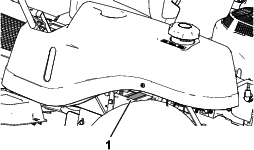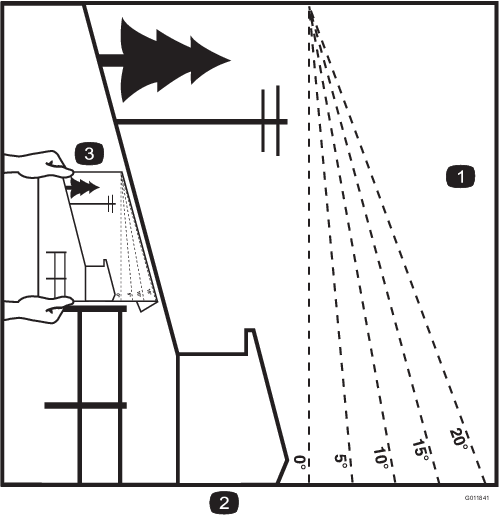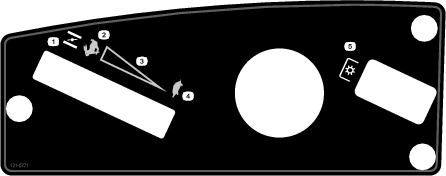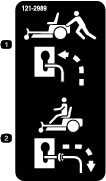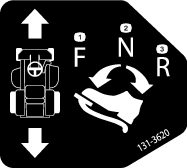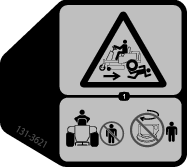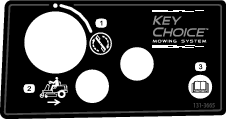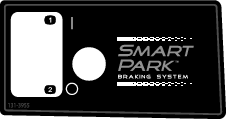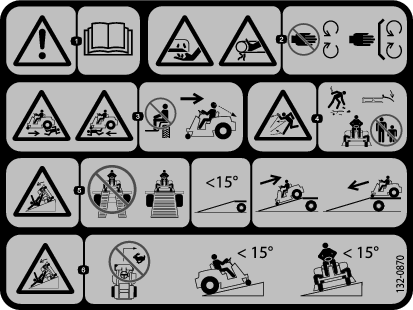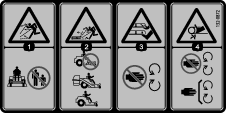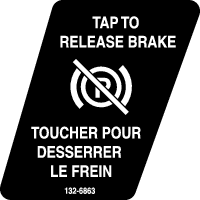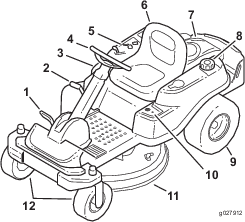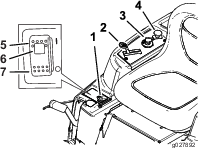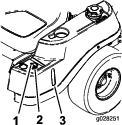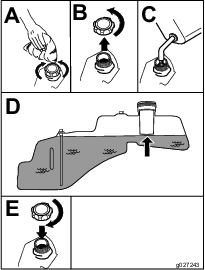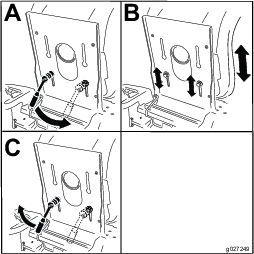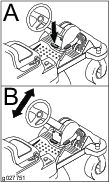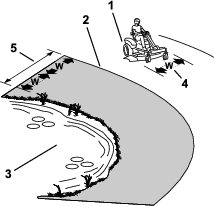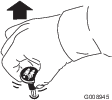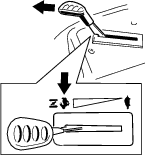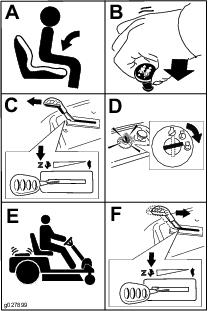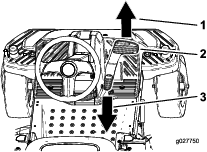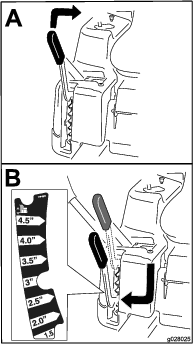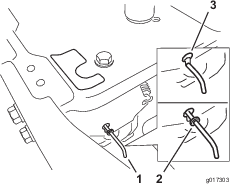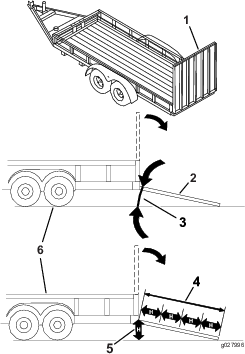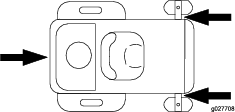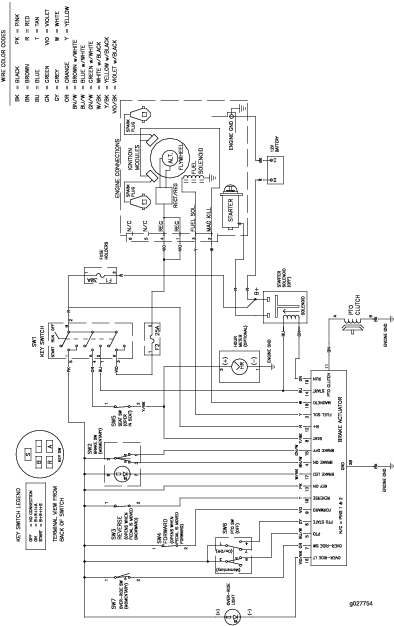Maintenance
Note: Determine the left and right sides of the machine from the normal operating position.
Recommended Maintenance Schedule(s)
| Maintenance Service Interval | Maintenance Procedure |
|---|---|
| After the first 5 hours |
|
| Before each use or daily |
|
| After each use |
|
| Every 25 hours |
|
| Every 50 hours |
|
| Every 100 hours |
|
| Every 200 hours |
|
| Before storage |
|
Caution
If you leave the key in the switch, someone could accidently start the engine and seriously injure you or other bystanders.
Remove the key from the switch before you perform any maintenance.
Pre-Maintenance Procedures
Maintenance Safety
-
Before repairing the machine do the following:
-
Disengage the drives.
-
Engage the parking brake.
-
Shut off the engine and remove the key.
-
Disconnect the spark-plug wire.
-
-
Park the machine on a level surface.
-
Clean grass and debris from the cutting unit, drives, mufflers, and engine to help prevent fires.
-
Clean up oil or fuel spills.
-
Do not allow untrained personnel to service the machine.
-
Use jack stands to support the machine and/or components when required.
-
Carefully release pressure from components with stored energy.
-
Disconnect the battery or remove the spark-plug wire before making any repairs. Disconnect the negative terminal first and the positive terminal last. Connect the positive terminal first and negative last.
-
Use care when checking the blades. Wrap the blade(s) or wear thickly padded gloves, and use caution when servicing them. Only replace blades; do not straighten or weld them.
-
Keep your hands and feet away from moving parts. If possible, do not make adjustments with the engine running.
-
Keep all parts in good working condition and all hardware tightened, especially the blade-attachment bolts. Replace all worn or damaged decals.
-
Never interfere with the intended function of a safety device or reduce the protection provided by a safety device. Check their proper operation regularly.
-
To ensure optimum performance and continued safety certification of the machine, use only genuine Toro replacement parts and accessories. Replacement parts and accessories made by other manufacturers could be dangerous, and such use could void the product warranty.
-
Check the parking brake operation frequently. Adjust and service as required.
Raising the Seat
Ensure that the parking brake is engaged. Lift the seat forward.
You can access following components by raising the seat:
-
Serial plate
-
Service decal
-
Seat-adjustment bolts (if applicable)
-
Fuel filter
-
Battery and battery cables
Raising the Front of the Machine
If the front of the machine needs to be raised, use the very front edge as shown in Figure 24.
Important: To prevent damage to the steering mechanism, use the very front edge of the machine for a jacking point.
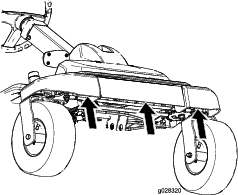
Lubrication
Greasing the Bearings
| Maintenance Service Interval | Maintenance Procedure |
|---|---|
| Every 25 hours |
|
Grease Type: No. 2 lithium grease
-
Park the machine on a level surface, disengage the blade-control switch, and engage the parking brake; refer to Shutting Off the Engine.
-
Shut off the engine, remove the key, and wait for all moving parts to stop before leaving the operating position.
-
Clean the grease fittings (Figure 25 and Figure 26) with a rag.
Note: Scrape any paint off the front of the fitting(s).
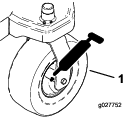

-
Connect a grease gun to each fitting (Figure 25 and Figure 26).
-
Pump grease into the fittings until grease begins to ooze out of the bearings.
-
Wipe up any excess grease.
Engine Maintenance
Engine Safety
-
Shut off the engine before checking the oil or adding oil to the crankcase.
-
Keep your hands, feet, face, clothing, and other body parts away the muffler and other hot surfaces.
Servicing the Air Cleaner
Note: Service the air cleaner more frequently (every few hours) if operating conditions are extremely dusty or sandy.
Removing the Foam and Paper Elements
-
Park the machine on a level surface, disengage the blade-control switch (PTO), and engage the parking brake.
-
Shut off the engine, remove the key, and wait for all moving parts to stop before leaving the operating position.
-
Clean around the air cleaner to prevent dirt from getting into the engine and causing damage.
-
Remove the air-cleaner cover by unscrewing the 2 knobs (Figure 27).
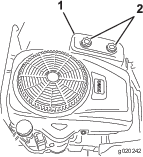
-
Carefully remove the foam and paper filter elements from the air-cleaner housing (Figure 28).
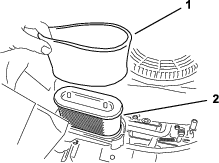
-
Separate the foam and paper elements.
Servicing the Air-Cleaner Foam Element
| Maintenance Service Interval | Maintenance Procedure |
|---|---|
| Before each use or daily |
|
-
Wash the foam element in liquid soap and warm water. When the element is clean, rinse it thoroughly.
-
Dry the element by squeezing it in a clean cloth.
Important: Replace the foam element if it is torn or worn.
Servicing the Air-Cleaner Paper Element
| Maintenance Service Interval | Maintenance Procedure |
|---|---|
| Every 50 hours |
|
-
Clean the paper element by tapping it gently to remove dust.
Note: If it is very dirty, replace the paper element (Figure 28).
-
Inspect the element for tears, an oily film, or damage to the rubber seal.
-
Replace the paper element if it is damaged.
Important: Do not clean the paper filter.
Installing the Foam and Paper Elements
Important: To prevent engine damage, always operate the engine with the complete foam and paper air cleaner assembly installed.
Servicing the Engine Oil
Engine-Oil Specifications
Oil Type: Detergent oil (API service SF, SG, SH, SJ, or higher)
Crankcase Capacity: 1.4 L (47 fl oz) with oil filter
Viscosity: See the table below.
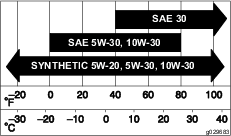
Checking the Engine-Oil Level
| Maintenance Service Interval | Maintenance Procedure |
|---|---|
| Before each use or daily |
|
Note: Check the oil when the engine is cold.
Important: If you overfill or underfill the engine crankcase with oil and run the engine, you may damage the engine.
-
Park the machine on a level surface, disengage the blade-control switch (PTO), and engage the parking brake.
-
Shut off the engine, remove the key, and wait for all moving parts to stop before leaving the operating position.
Note: Ensure that the engine is cool so that the oil has had time to drain into the sump.
-
To keep dirt, grass clippings, etc., out of the engine, clean the area around the oil-fill cap and dipstick before removing it (Figure 30).
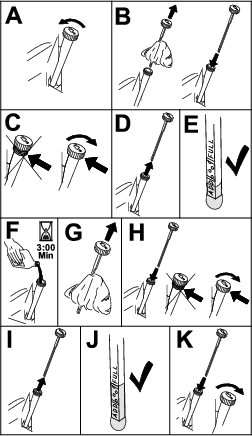
Changing the Engine Oil and Filter
| Maintenance Service Interval | Maintenance Procedure |
|---|---|
| After the first 5 hours |
|
| Every 100 hours |
|
-
Park the machine so that the drain side is slightly lower than the opposite side to ensure that the oil drains completely.
-
Disengage the blade-control switch (PTO) and engage the parking brake.
-
Shut off the engine, remove the key, and wait for all moving parts to stop before leaving the operating position.
-
Drain the oil from the engine.
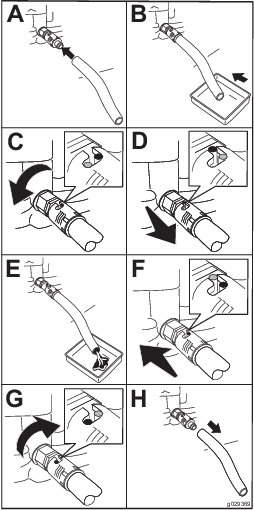
-
Change the engine-oil filter (Figure 32).
Note: Ensure the oil-filter gasket touches the engine, and then turn the filter an extra 3/4 turn.
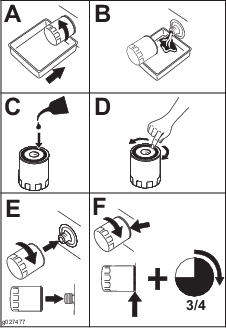
-
Slowly pour approximately 80% of the specified oil into the filler tube and slowly add the additional oil to bring it to the Full mark (Figure 33).
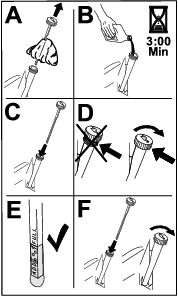
-
Dispose of the used oil at a recycling center.
Servicing the Spark Plug
| Maintenance Service Interval | Maintenance Procedure |
|---|---|
| Every 50 hours |
|
| Every 100 hours |
|
Ensure that the air gap between the center and side electrodes is correct before installing the spark plug. Use a spark plug wrench for removing and installing the spark plug and a gapping tool or feeler gauge to check and adjust the air gap. Install a new spark plug if necessary.
Type: Champion® RC12YC, Autolite® 3924, or NGK® BCPR6ES
Air Gap: 0.75 mm (0.03 inch)
Removing the Spark Plug
-
Park the machine on a level surface, disengage the blade-control switch (PTO), and engage the parking brake.
-
Shut off the engine, remove the key, and wait for all moving parts to stop before leaving the operating position.
-
Clean the area around the base of the plug to keep dirt and debris out of the engine.
-
Remove the spark plug (Figure 34).
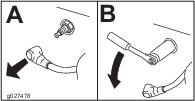
Checking the Spark Plug
Important: Do not clean the spark plug(s). Always replace the spark plug(s) when it has a black coating, worn electrodes, an oily film, or cracks.
If you see light brown or gray on the insulator, the engine is operating properly. A black coating on the insulator usually means the air cleaner is dirty.
Set the gap to 0.75 mm (0.03 inch).
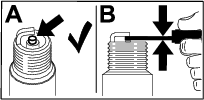
Installing the Spark Plug
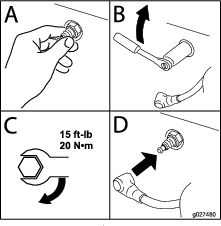
Cleaning the Blower Housing
| Maintenance Service Interval | Maintenance Procedure |
|---|---|
| Every 100 hours |
|
To ensure proper cooling, ensure that the grass screen, cooling fins, and other external surfaces of the engine are kept clean at all times.
Clean the cooling fins and external surfaces as necessary. Make sure that the cooling shrouds are installed. Torque the blower housing screws to 7.5 N∙m (5.5 ft-lb).
Important: Operating the engine with a blocked grass screen, dirty or plugged cooling fins, and/or cooling shrouds removed, causes engine damage due to overheating.
Fuel System Maintenance
Danger
In certain conditions, fuel is extremely flammable and highly explosive. A fire or explosion from fuel can burn you, others, and can damage property.
-
Perform any fuel-related maintenance when the engine is cold. Do this outdoors in an open area. Wipe up any fuel that spills.
-
Never smoke when draining fuel, and stay away from an open flame or where a spark may ignite the fuel fumes.
Replacing the In-Line Fuel Filter
| Maintenance Service Interval | Maintenance Procedure |
|---|---|
| Every 100 hours |
|
| Every 200 hours |
|
Never install a dirty filter after removing it from the fuel line.
-
Park the machine on a level surface, disengage the blade-control switch (PTO), and engage the parking brake.
-
Shut off the engine, remove the key, and wait for all moving parts to stop before leaving the operating position.

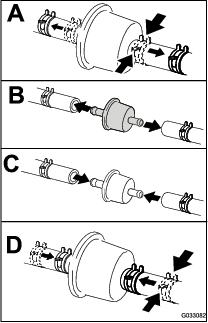
Electrical System Maintenance
Electrical System Safety
-
Disconnect the battery before repairing the machine. Disconnect the negative terminal first and the positive last. Connect the positive terminal first and the negative last.
-
Charge the battery in an open, well-ventilated area, away from sparks and flames. Unplug the charger before connecting or disconnecting the battery. Wear protective clothing and use insulated tools.
Warning
Battery posts, terminals, and related accessories contain lead and lead compounds, chemicals known to the State of California to cause cancer and reproductive harm. Wash hands after handling.
Servicing the Battery
Removing the Battery
Warning
Battery terminals or metal tools could short against metal machine components, causing sparks. Sparks can cause the battery gasses to explode, resulting in personal injury.
-
When removing or installing the battery, do not allow the battery terminals to touch any metal parts of the machine.
-
Do not allow metal tools to short between the battery terminals and metal parts of the machine.
-
Park the machine on a level surface, disengage the blade-control switch (PTO), and engage the parking brake.
-
Shut off the engine, remove the key, and wait for all moving parts to stop before leaving the operating position.
-
Raise the seat to access the battery.
-
Disconnect the negative (black) ground cable from the battery post (Figure 38).
Note: Retain all fasteners.
Warning
Incorrectly removing the cables from battery could damage the machine and cables, causing sparks. Sparks can cause the battery gasses to explode, resulting in personal injury.
-
Always disconnect the negative (black) battery cable before disconnecting the positive (red) cable.
-
Always connect the positive (red) battery cable before connecting the negative (black) cable.
-
-
Slide the rubber cover off the positive (red) cable.
-
Disconnect the positive (red) cable from the battery post (Figure 38).
Note: Retain all fasteners.
-
Remove the battery hold-down (Figure 38), and lift the battery from the battery tray.
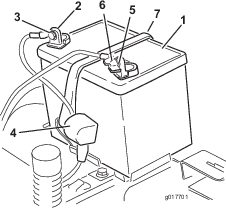
Charging the Battery
| Maintenance Service Interval | Maintenance Procedure |
|---|---|
| Before storage |
|
-
Remove the battery from the chassis; refer to Removing the Battery.
-
Charge the battery for a minimum of 1 hour at 6 to 10 A.
Note: Do not overcharge the battery.
-
When the battery is fully charged, unplug the charger from the electrical outlet, then disconnect the charger leads from the battery posts (Figure 39).
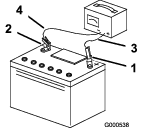
Installing the Battery
-
Position the battery in the tray (Figure 38).
-
Using the fasteners previously removed, install the positive (red) battery cable to the positive (+) battery terminal.
-
Using the fasteners previously removed, install the negative battery cable to the negative (-) battery terminal.
-
Slide the red terminal boot onto the positive (red) battery post.
-
Secure the battery with the hold-down (Figure 38).
-
Lower the seat.
Servicing the Fuses
The electrical system is protected by fuses. It requires no maintenance; however, if a fuse blows, check the component/circuit for a malfunction or short.
Fuse type:
-
Main—F1 (30 A, blade-type)
-
Charge Circuit—F2 (25 A, blade-type)
-
Remove the screws securing the control panel to the machine.
Note: Retain all fasteners.
-
Lift the control pane up to access the main wire harness and fuse block (Figure 40).
-
To replace a fuse, pull out the fuse to remove it (Figure 40).
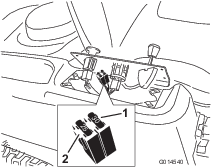
-
Return the control panel to its original position.
Note: Use the screws removed previously to secure the panel to the machine.
Drive System Maintenance
Checking the Tire Pressure
| Maintenance Service Interval | Maintenance Procedure |
|---|---|
| Every 25 hours |
|
Maintain the air pressure in the front and rear tires as specified. Uneven tire pressure can cause an uneven cut. Check the pressure at the valve stem (Figure 41). Check the tires when they are cold to get the most accurate pressure reading.
Refer to the maximum pressure suggested by the tire manufacturer on the sidewall of the caster wheel tires.
Inflate the rear drive-wheel tires to 90 kPa (13 psi).

Releasing the Electric Brake
You can manually release the electric brake by rotating the link arms forward. Once the electric brake is energized, the brake resets.
-
Turn the key to the OFF position or disconnect the battery.
-
Locate the shaft on the electric brake where the brake link arms are connected (Figure 42).
-
Rotate the shaft forward to release the brake.
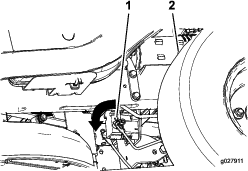
Belt Maintenance
Inspecting the Belts
| Maintenance Service Interval | Maintenance Procedure |
|---|---|
| Every 25 hours |
|
Replace the belt if it is worn. The signs of a worn belt include squealing while the belt is rotating; the blades slipping while cutting grass; and frayed edges, burn marks, and cracks on the belt.
Replacing the Mower Belt
Warning
The spring is under tension when installed and can cause personal injury.
Be careful when removing the belt.
-
Park the machine on a level surface, disengage the blade-control switch (PTO), and engage the parking brake.
-
Shut off the engine, remove the key, and wait for all moving parts to stop before leaving the operating position.
-
Set the height of cut at the lowest cutting position (38 mm (1-1/2 inches).
-
Using a spring-removal tool (Toro Part No. 92-5771), remove the idler spring from the deck hook to remove tension on the idler pulley and roll the belt off the pulleys (Figure 43).
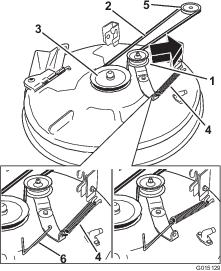
-
Route the new belt around the engine pulley and mower pulleys (Figure 43).
-
Using a spring-removal tool (Toro Part No. 92-5771), install the idler spring over the deck hook and place tension on the idler pulley and the mower belt (Figure 43).
-
Install the pulley covers.
Mower Maintenance
Servicing the Cutting Blades
To ensure a superior quality of cut, keep the blades sharp. For convenient sharpening and replacement, keep extra blades on hand.
Blade Safety
A worn or damaged blade can break, and a piece of the blade could be thrown toward you or bystanders, resulting in serious personal injury or death. Trying to repair a damaged blade may result in discontinued safety certification of the product.
-
Inspect the blades periodically for wear or damage.
-
Use care when checking the blades. Wrap the blades or wear gloves, and use caution when servicing the blades. Only replace or sharpen the blades; never straighten or weld them.
-
On multi-bladed machines, take care as rotating 1 blade can cause other blades to rotate.
Before Inspecting or Servicing the Blades
-
Park the machine on a level surface, disengage the blade-control switch (PTO), and engage the parking brake.
-
Shut off the engine, remove the key, and disconnect the spark-plug wires from the spark plugs.
Inspecting the Blades
| Maintenance Service Interval | Maintenance Procedure |
|---|---|
| Before each use or daily |
|
-
Inspect the cutting edges (Figure 44).
-
If the edges are not sharp or have nicks, remove and sharpen the blade; refer to Sharpening the Blades.
-
Inspect the blades, especially in the curved area.
-
If you notice any cracks, wear, or a slot forming in this area, immediately install a new blade (Figure 44).
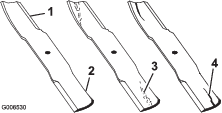
Checking for Bent Blades
Note: The machine must be on a level surface for the following procedure.
-
Raise the mower deck to the highest height-of-cut position.
-
While wearing thickly padded gloves, or other adequate hand protection, slowly rotate the blade into a position that allows you to measure the distance between the cutting edge and the level surface the machine is on (Figure 45).
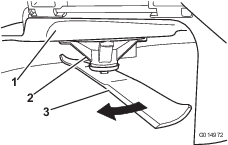
-
Measure from the tip of the blade to the flat surface (Figure 46).
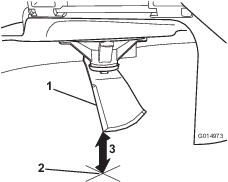
-
Rotate the same blade 180 degrees so that the opposing cutting edge is now in the same position (Figure 47).
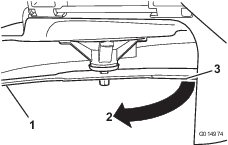
-
Measure from the tip of the blade to the flat surface (Figure 48).
Note: The variance should be no more than 3 mm (1/8 inch).

-
If the difference between A and B is greater than 3 mm (1/8 inch), replace the blade with a new blade; refer to Removing the Mower Deck and Installing the Mower Deck.
Note: If a bent blade is replaced with a new blade, and the dimension obtained continues to exceed 3 mm (1/8 inch), the blade spindle could be bent. Contact an Authorized Service Dealer for service.
-
If the variance is within constraints, move to the next blade.
-
-
Repeat this procedure on each blade.
Removing the Blades
Replace the blades if they hit a solid object, or if the blade is out of balance or bent.
-
Hold the blade end using a rag or thickly padded glove.
-
Remove the blade bolt, curved washer, and blade from the spindle shaft (Figure 49).
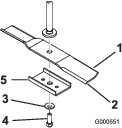
Sharpening the Blades
-
Use a file to sharpen the cutting edge at both ends of the blade (Figure 50).
Note: Maintain the original angle.
Note: The blade retains its balance if the same amount of material is removed from both cutting edges.

-
Check the balance of the blade by putting it on a blade balancer (Figure 51).
Note: If the blade stays in a horizontal position, the blade is balanced and can be used.
Note: If the blade is not balanced, file some metal off the end of the sail area only (Figure 50).

-
Repeat this procedure until the blade is balanced.
Installing the Blades
-
Install the blade onto the spindle shaft (Figure 49).
Important: The curved part of the blade must be pointing upward toward the inside of the mower to ensure proper cutting.
-
Install the blade stiffener, curved washer (cupped side toward the blade), and blade bolt (Figure 49).
-
Torque the blade bolt to 47 to 88 N∙m (35 to 65 ft-lb).
Leveling the Mower Deck
Check to ensure that the mower deck is level any time you install the mower or when you see an uneven cut on your lawn.
Check the mower deck for bent blades prior to leveling; remove and replace any bent blades; refer to the Checking for Bent Blades before continuing.
Level the mower deck side-to-side first, then adjust the front to rear slope.
Requirements:
-
The machine must be on a level surface.
-
All tires must be properly inflated; refer to Checking the Tire Pressure.
Leveling from Side to Side
-
Park the machine on a level surface, disengage the blade-control switch (PTO), and engage the parking brake.
-
Shut off the engine, remove the key, and wait for all moving parts to stop before leaving the operating position.
-
Set the height-of-cut lever to the middle position.
-
Carefully rotate the blade(s) so that they are all side to side (Figure 52).
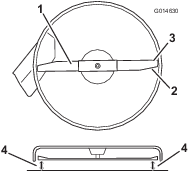
-
Measure between the outside cutting edges and the flat surface (Figure 52).
Note: If both measurements are not within 5 mm (3/16 inch), an adjustment is required; continue with this procedure.
-
Move to the left side of the machine.
-
Loosen the side locking nut.
-
Raise or lower the left side of the mower deck by rotating the rear locking nut (Figure 53).
Note: Rotate the rear locking nut clockwise to raise the mower deck; rotate the rear locking nut counter-clockwise to lower the mower deck (Figure 53).
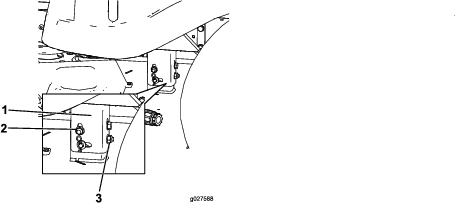
-
Check the side-to-side adjustments again; repeat this procedure until the measurements are correct.
-
Continue leveling the mower deck by checking the front-to-rear blade slope; refer to Adjusting the Front-to-Rear Blade Slope.
Adjusting the Front-to-Rear Blade Slope
Check the front-to-rear blade level any time you install the mower. If the front of the mower is more than 7.9 mm (5/16 inch) lower than the rear of the mower, adjust the blade level using the following instructions:
-
Park the machine on a level surface, disengage the blade-control switch (PTO), and engage the parking brake.
-
Shut off the engine, remove the key, and wait for all moving parts to stop before leaving the operating position.
-
Set the height-of-cut lever to the middle position.
Note: Check and adjust the side-to-side blade level if you have not checked the setting; refer to Leveling from Side to Side.
-
Carefully rotate the blade so they are facing front to rear (Figure 54).
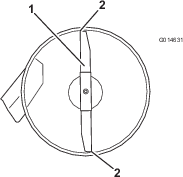
-
Measure from the tip of the front blade to the flat surface, and the tip of the rear blade to the flat surface (Figure 54).
Note: If the front blade tip is not 1.6 to 7.9 mm (1/16 to 5/16 inch) lower than the rear blade tip, adjust the front locknut.
-
To adjust the front-to-rear blade slope, rotate the adjustment nut in the front of the mower (Figure 55).
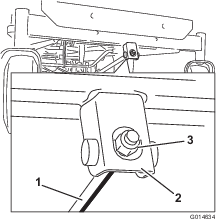
-
To raise the front of the mower, tighten the adjustment nut.
-
To lower the front of the mower, loosen the adjustment nut.
-
After adjustment, check the front-to-rear slope again, continue adjusting the nut until the front blade tip is 1.6 to 7.9 mm (1/16 to 5/16 inch) lower than the rear blade tip (Figure 54).
-
When the front-to-rear blade slope is correct, check the side-to-side level of the mower again; refer to Leveling from Side to Side.
Removing the Mower Deck
-
Park the machine on a level surface, disengage the blade-control switch (PTO), and engage the parking brake.
-
Shut off the engine, remove the key, and wait for all moving parts to stop before leaving the operating position.
-
Lower the height-of-cut lever to the lowest position.
-
Remove the hairpin cotter from the front support rod, and remove the rod from the deck bracket (Figure 56).
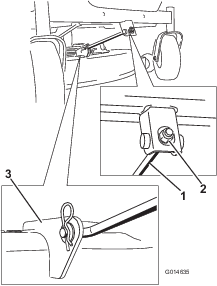
-
Carefully lower the front of the mower deck to the ground.
-
Lift the mower deck and hanger brackets clear of the rear lift rod and lower the mower carefully to the ground (Figure 57).
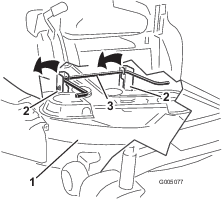
-
Slide the mower deck rearward to remove the mower belt from the engine pulley.
-
Slide the mower deck out from underneath the machine.
Note: Retain all parts for future installation.
Installing the Mower Deck
-
Park the machine on a level surface, disengage the blade-control switch (PTO), and engage the parking brake.
-
Shut off the engine, remove the key, and wait for all moving parts to stop before leaving the operating position.
-
Slide the mower under the machine.
-
Lower the height-of-cut lever to the lowest position.
-
Lift the rear of the mower deck and guide the hanger brackets over the rear lift rod (Figure 57).
-
Attach the front support rod to the mower deck with the clevis pin and hairpin cotter (Figure 56).
-
Install the mower belt onto the engine pulley; refer to Replacing the Mower Belt.
Replacing the Grass Deflector
| Maintenance Service Interval | Maintenance Procedure |
|---|---|
| Before each use or daily |
|
Warning
An uncovered discharge opening could allow the machine to throw objects toward you or bystanders, resulting in serious injury. Also, contact with the blade could occur.
Never operate the machine without the grass deflector, the discharge cover, or the grass-collection system in place.
-
Remove the nut (3/8 inch) from the rod under the mower (Figure 58).
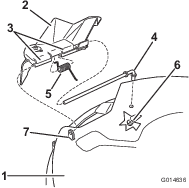
-
Slide the rod out of the short stand-off, spring, and grass deflector (Figure 58).
-
Remove the damaged or worn grass deflector.
-
Replace the grass deflector (Figure 58).
-
Slide the rod, straight end, through the rear grass deflector bracket.
-
Place the spring on the rod, with end wires down, and between the grass deflector brackets.
-
Slide the rod through the second grass-deflector bracket (Figure 58).
-
Insert the rod at the front of the grass deflector into the short standoff on the deck.
-
Secure the rear end of the rod into the mower with a nut (3/8 inch) as shown in Figure 58.
Important: The grass deflector must be spring-loaded in the down position. Lift the deflector up to test that it snaps into the full-down position.
Cleaning
Cleaning under the Front of the Machine
| Maintenance Service Interval | Maintenance Procedure |
|---|---|
| After each use |
|
Remove debris under the front of the machine with compressed air or by hand with a brush (Figure 59).
Note: Do not use water to clean under the front of the machine; this can cause buildup of debris.
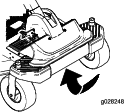
Washing the Underside of the Mower Deck
| Maintenance Service Interval | Maintenance Procedure |
|---|---|
| After each use |
|
Important: You can wash the machine with a mild detergent and water. Do not pressure wash the machine. Avoid excessive use of water, especially near the control panel, under the seat, around the engine, hydraulic pumps, and motors.
Wash the underside of the mower deck after each use to prevent grass buildup for improved mulch action and clipping dispersal.
-
Park the machine on a level surface, disengage the blade-control switch (PTO), and engage the parking brake.
-
Shut off the engine, remove the key, and wait for all moving parts to stop before leaving the operating position.
-
Attach the hose coupling to the end of the mower washout fitting, and turn the water on high (Figure 60).
Note: Spread petroleum jelly on the washout fitting O-ring to make the coupling slide on easier and protect the O-ring.
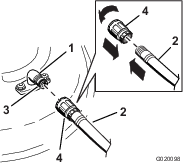
-
Lower the mower to the lowest height-of-cut.
-
Sit on the seat and start the engine.
-
Engage the blade-control switch and let the mower run for 1 to 3 minutes.
-
Disengage the blade-control switch, shut off the engine, remove the ignition key, and wait for all moving parts to stop.
-
Turn the water off and remove the coupling from the washout fitting.
Note: If the mower is not clean after 1 washing, soak it and let it stand for 30 minutes. Then, repeat the process.
-
Run the mower again for 1 to 3 minutes to remove excess water.
Warning
A broken or missing washout fitting could expose you and others to thrown objects or blade contact. Contact with a blade or thrown debris can cause injury or death.
-
Replace broken or missing washout fitting immediately, before using machine again.
-
Never put your hands or feet under the mower or through openings in the machine.
-
Disposing of Waste
Engine oil, batteries, hydraulic fluid, and engine coolant are pollutants to the environment. Dispose of these according to your state and local regulations.
